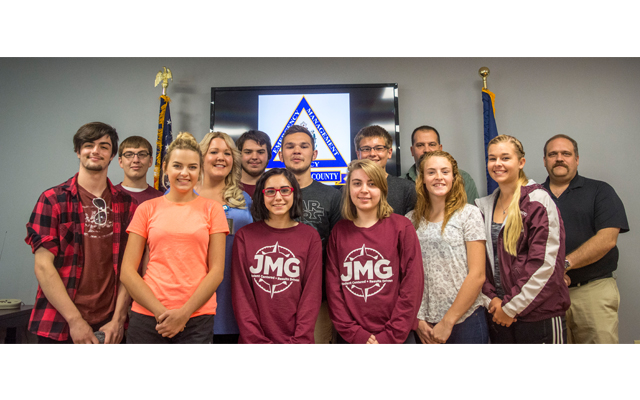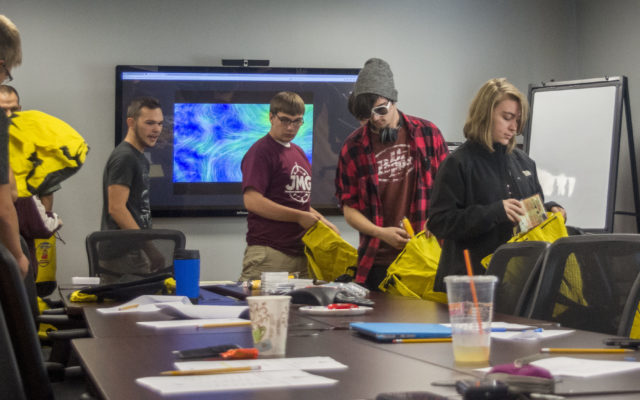
CARIBOU, Maine — The Aroostook County Emergency Management Agency recently adopted a nationwide training program that allows high schoolers to become leaders in their homes and communities by learning how to teach others about disaster preparedness.
Since Aroostook EMA’s office is in Caribou, staffers invited Caribou High School’s JMG (Jobs for Maine Graduates) class to be the first in The County to participate in the training.
Students spent most of Friday, Sept. 15 at the EMA office, which is less than a mile away from the high school, as EMA Planner Dan Conklin prepared the students to teach fourth graders, as well as family members, how to be prepared for disasters.
“This program has had success in other parts of Maine, such as York and Franklin counties, so we decided it was a good idea to invite Caribou to participate,” Conklin said.
Conklin praised the program’s potential to not only reach one class, but the fourth graders the high school students will subsequently teach, and their families.
“It’s a win-win scenario,” Conklin said, “and it’s been proven that if you teach a child how to cope with a disaster, they will be less afraid if it happens. It’s a tremendous program and I hope it succeeds.”
All participating students are given a yellow bag containing a flashlight, a mylar heat blanket, hand warmers, a first aid kit, and a whistle.
“One thing I tell them about the whistle is that, let’s say a small tornado comes through and knocks down your house,” Conklin said. “If you have the bag with you, you could blow the whistle and you’re much more likely to be saved if people are looking for you.”
While Maine occasionally has seen a few small tornadoes, Aroostook EMA Director Darren Woods said the training program is tailored to the disasters most common in the region in which it is taught. The Aroostook program, for example, focuses on extreme cold, winter-power outages, and spring flooding.
By teaching high school students to teach others, the program allows EMA to educate a much larger number of community members than the small staff could reach otherwise.
“We don’t have enough staff to get out and teach like we’d like to,” Woods said. “The pilot is meant to teach kids to be a force multiplier for us. It’s good for them because they get to learn about preparedness and use the skills they learned in JMG while teaching other kids and becoming leaders when they deliver that information.”
Woods said the program would continue on a yearly basis if all goes well with the pilot, and that its success is dependent on feedback from teachers and students.
“We provide surveys before and after the program,” Woods said. “At the end of the program, we ask the same questions and look at the changes from start to finish. We look at several aspects such as whether or not we provided the right material, or if the program was long or short enough.”
Woods added that it will take years in order to truly determine the program’s success.
- Caribou JMG students line up to take STEP (Student Tools for Emergency Preparedness) bags during a Sept. 15 workshop in which they learned how to teach younger students about the proper response to disasters at the Aroostook County Emergency Management Agency building in Caribou. (Christopher Bouchard)
“Just like the “Learn Not to Burn” program, you won’t know for quite some time if it was successful and you see the overall mentality of the community change,” Woods said.
From a student leadership perspective, JMG Specialist Valerie Waldemarson said the program will have more immediate benefits.
“This is a huge extension of what students spend their class time doing,” Waldemarson said Friday. “They learn leadership by teaching younger students, which is a huge responsibility for a teenager to take on, and the fact that they want to do it shows that they want to be a leader.”
Waldemarson said the program was a “perfect fit” for her JMG class at Caribou High School.
“Our students strive to engage in the community,” Waldemarson said. “These are life skills that everyone needs and students can go out and deliver that message, and become leaders in their own families.”
CHS Sophomore James Belyea said he has already learned a great deal through the program.
“I didn’t know we could have hurricanes up here,” he said. “It’s not as bad as it can be down south, but it could still be pretty powerful up here, especially on the East Coast.”
The best course of action in the event that Aroostook is hit by the remnants of a hurricane is to have an emergency kit, find a place safe from flooding, and listen to what the authorities say, Belyea said.
The teen also commented on the ability to teach younger students in the community.
“It’s nice to be able to teach younger kids what to do in these situations,” Belyea said. “It’s easy to get panicked about disasters and emergencies, so it’s good for younger kids to know what to do so they don’t make the situation worse for themselves.”
CHS Senior Jaelynn Doody also commented on learning about disasters that many in the region don’t expect.
“We learned about earthquakes, which don’t get that bad, but they can happen,” Doody said. “If they do, you need to protect your head and get somewhere safe and stay there until you hear otherwise because of the possibility of aftershocks.”








